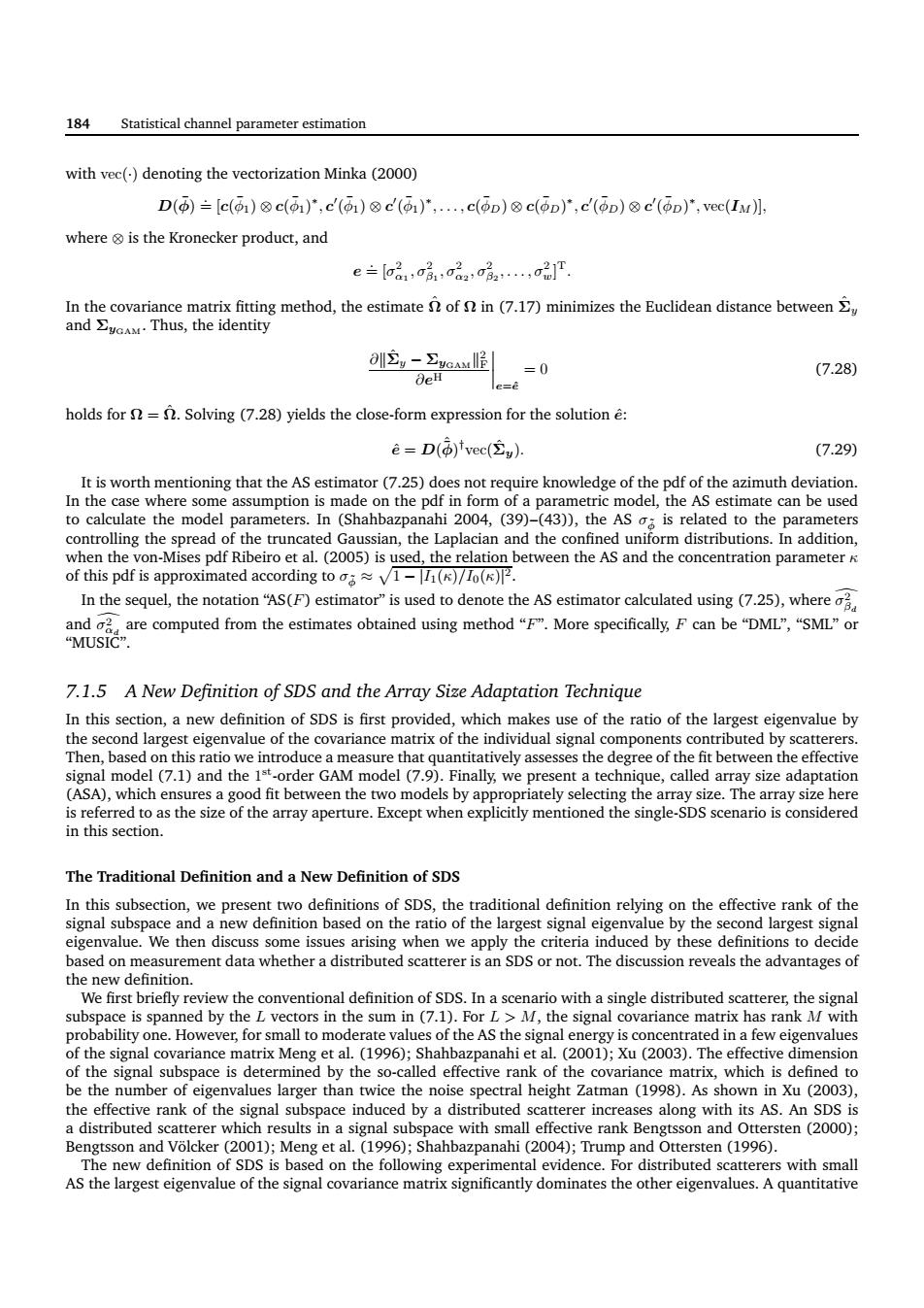正在加载图片...

184 Statistical channel parameter estimation with ve()denoting the vectorization Minka(2000) D()[c()⑧c(di),c'(di)⑧c(何)',,c(p)c(op),c(p)⑧c(p)',ec(L where is the Kronecker product,and e-0a1:..u GAM =0 (7.28) holds forSolving (7.28)yields the close-form expression for the solution: e=D(avec(②), (7.29) It is worth azimuth deviatio tocalculare the model parameters.In (Shahbazpanahi of this pdf is approximated according to1-()/To( In the sequel,the notation"AS(F estimator"is used to denote the AS estimator calculated using (7.25),where re computed from the estimates obtained using methodMore specifically,can be DML"SML 7.1.5 ANew Definition of SDS and the Array Size Adaptation Technique which s use of the ratio of the largest eigenvalue by antitatively asse model (and the order GAM model (7.9 Finally,we pre sent a techni que,called array size adaptation in this section. The traditional definition and a new Definition of SDs ssion reveals the advantages of bsrifly review the conve.na sceo with a single distributed scaerer of the vm As the hes1g知al trix Men al. 996:5 ective c cral heisht Zatman (998).As shown in xu (2003) the effective rank of the signal su space induced by a distributed scatterer increases along with its AS.An SDS is and Volck ve rank E son ar en2000 fio of spSis based on the fowin eperimental eridnctribur L 1 061 with small AS the largest eigenvalue of the signal covariance matrix significantly dominates the other eigenvalues.A quantitative184 Statistical channel parameter estimation with vec(·) denoting the vectorization Minka (2000) D(φ¯) .= [c(φ¯ 1) ⊗ c(φ¯ 1) ∗ , c ′ (φ¯ 1) ⊗ c ′ (φ¯ 1) ∗ , . . . , c(φ¯D) ⊗ c(φ¯D) ∗ , c ′ (φ¯D) ⊗ c ′ (φ¯D) ∗ , vec(IM )], where ⊗ is the Kronecker product, and e .= [σ 2 α1 , σ2 β1 , σ2 α2 , σ2 β2 , . . . , σ2 w] T. In the covariance matrix fitting method, the estimate Ωˆ of Ω in (7.17) minimizes the Euclidean distance between Σˆ y and ΣyGAM. Thus, the identity ∂kΣˆ y − ΣyGAMk 2 F ∂eH
e=eˆ = 0 (7.28) holds for Ω = Ωˆ . Solving (7.28) yields the close-form expression for the solution eˆ: eˆ = D(φ ˆ¯) † vec(Σˆ y). (7.29) It is worth mentioning that the AS estimator (7.25) does not require knowledge of the pdf of the azimuth deviation. In the case where some assumption is made on the pdf in form of a parametric model, the AS estimate can be used to calculate the model parameters. In (Shahbazpanahi 2004, (39)–(43)), the AS σφ˜ is related to the parameters controlling the spread of the truncated Gaussian, the Laplacian and the confined uniform distributions. In addition, when the von-Mises pdf Ribeiro et al. (2005) is used, the relation between the AS and the concentration parameter κ of this pdf is approximated according to σφ˜ ≈ p 1 − |I1(κ)/I0(κ)| 2. In the sequel, the notation “AS(F) estimator” is used to denote the AS estimator calculated using (7.25), where σd2 βd and σd2 αd are computed from the estimates obtained using method “F”. More specifically, F can be “DML”, “SML” or “MUSIC”. 7.1.5 A New Definition of SDS and the Array Size Adaptation Technique In this section, a new definition of SDS is first provided, which makes use of the ratio of the largest eigenvalue by the second largest eigenvalue of the covariance matrix of the individual signal components contributed by scatterers. Then, based on this ratio we introduce a measure that quantitatively assesses the degree of the fit between the effective signal model (7.1) and the 1 st-order GAM model (7.9). Finally, we present a technique, called array size adaptation (ASA), which ensures a good fit between the two models by appropriately selecting the array size. The array size here is referred to as the size of the array aperture. Except when explicitly mentioned the single-SDS scenario is considered in this section. The Traditional Definition and a New Definition of SDS In this subsection, we present two definitions of SDS, the traditional definition relying on the effective rank of the signal subspace and a new definition based on the ratio of the largest signal eigenvalue by the second largest signal eigenvalue. We then discuss some issues arising when we apply the criteria induced by these definitions to decide based on measurement data whether a distributed scatterer is an SDS or not. The discussion reveals the advantages of the new definition. We first briefly review the conventional definition of SDS. In a scenario with a single distributed scatterer, the signal subspace is spanned by the L vectors in the sum in (7.1). For L > M, the signal covariance matrix has rank M with probability one. However, for small to moderate values of the AS the signal energy is concentrated in a few eigenvalues of the signal covariance matrix Meng et al. (1996); Shahbazpanahi et al. (2001); Xu (2003). The effective dimension of the signal subspace is determined by the so-called effective rank of the covariance matrix, which is defined to be the number of eigenvalues larger than twice the noise spectral height Zatman (1998). As shown in Xu (2003), the effective rank of the signal subspace induced by a distributed scatterer increases along with its AS. An SDS is a distributed scatterer which results in a signal subspace with small effective rank Bengtsson and Ottersten (2000); Bengtsson and Völcker (2001); Meng et al. (1996); Shahbazpanahi (2004); Trump and Ottersten (1996). The new definition of SDS is based on the following experimental evidence. For distributed scatterers with small AS the largest eigenvalue of the signal covariance matrix significantly dominates the other eigenvalues. A quantitative